Love ‘Cosmos?’ Then NASA’s ‘Images Of A Space-Time Odyssey’ Will Make Your Jaw Drop (PHOTOS)
The premiere of “Cosmos,” Neil deGrasse Tyson’s new TV series, has a lot of science geeks massively pumped. And that includes the folks at NASA, who welcomed the 13-part series by releasing a stunning new gallery of space photos on Flickr.
From a psychedelic vortex on Saturn to monster solar flares to the beautiful remnants of dying stars, prepare to get seriously psyched about space. Just check out 30 of the amazing images below.
-
Red Dwarf Star
 Casey Reed/NASAArtist’s depiction of the powerful flare that erupted from the red dwarf star EV Lacertae in 2008.
Casey Reed/NASAArtist’s depiction of the powerful flare that erupted from the red dwarf star EV Lacertae in 2008. -
Venus
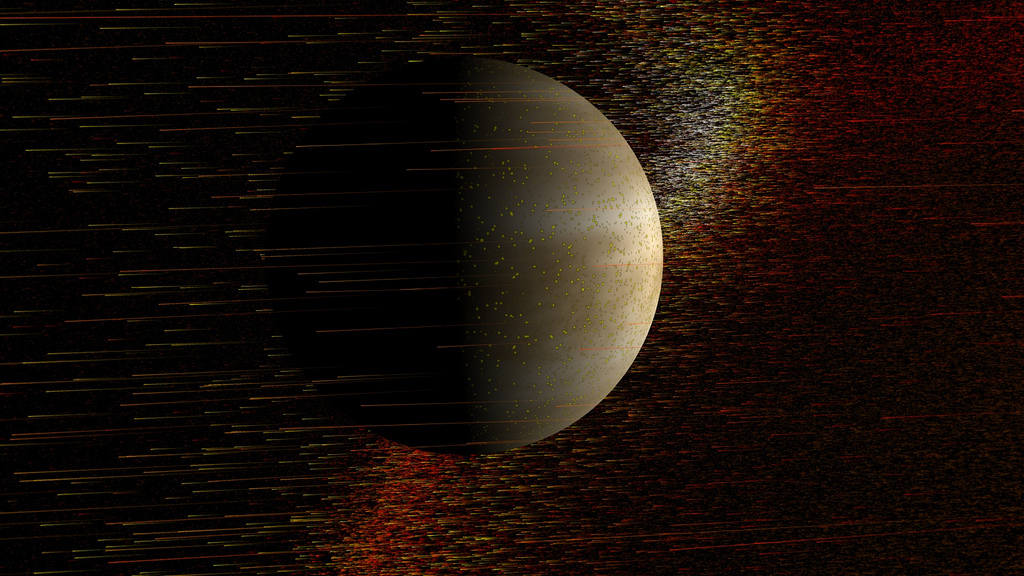 NASAUnlike Earth, Venus lacks a magnetic field to deflect powerful solar outbursts — as can be seen in this NASA-created image, a still from the video “Dynamic Earth: Exploring Earth’s Climate Engine.”
NASAUnlike Earth, Venus lacks a magnetic field to deflect powerful solar outbursts — as can be seen in this NASA-created image, a still from the video “Dynamic Earth: Exploring Earth’s Climate Engine.” -
Saturn’s Storm
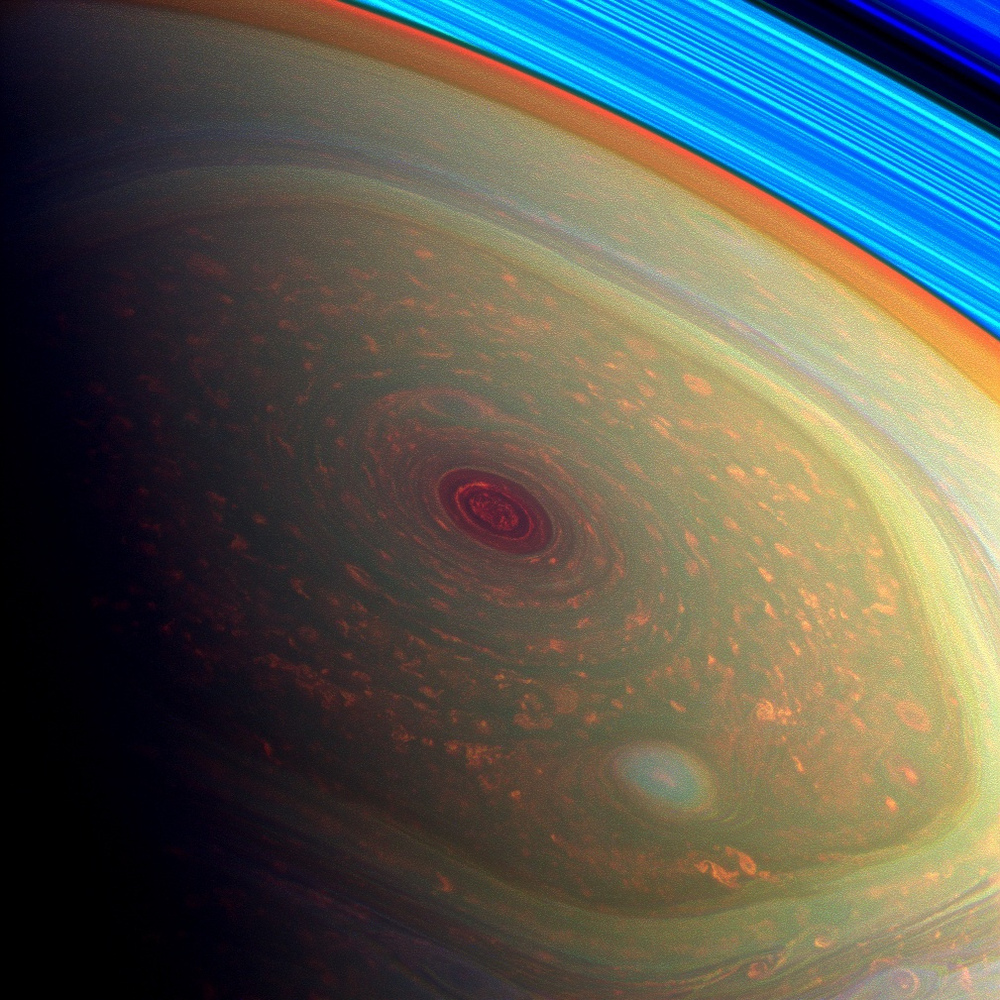 NASA/JPL-Caltech/SSIThis vertigo-inducing, false-color image from NASA’s Cassini mission highlights the storms at Saturn’s north pole. The angry eye of a hurricane-like storm appears dark red while the fast-moving hexagonal jet stream framing it is a yellowish green. Low-lying clouds circling inside the hexagonal feature appear as muted orange color. A second, smaller vortex pops out in teal at the lower right of the image. The rings of Saturn appear in vivid blue at the top right.
NASA/JPL-Caltech/SSIThis vertigo-inducing, false-color image from NASA’s Cassini mission highlights the storms at Saturn’s north pole. The angry eye of a hurricane-like storm appears dark red while the fast-moving hexagonal jet stream framing it is a yellowish green. Low-lying clouds circling inside the hexagonal feature appear as muted orange color. A second, smaller vortex pops out in teal at the lower right of the image. The rings of Saturn appear in vivid blue at the top right. -
Carina Nebula
 NASAThis Hubble photo is of a small portion of a large star-birthing region in the Carina Nebula. Towers of cool hydrogen laced with dust rise from the wall of the nebula.
NASAThis Hubble photo is of a small portion of a large star-birthing region in the Carina Nebula. Towers of cool hydrogen laced with dust rise from the wall of the nebula. -
Gas Falling Into A Black Hole
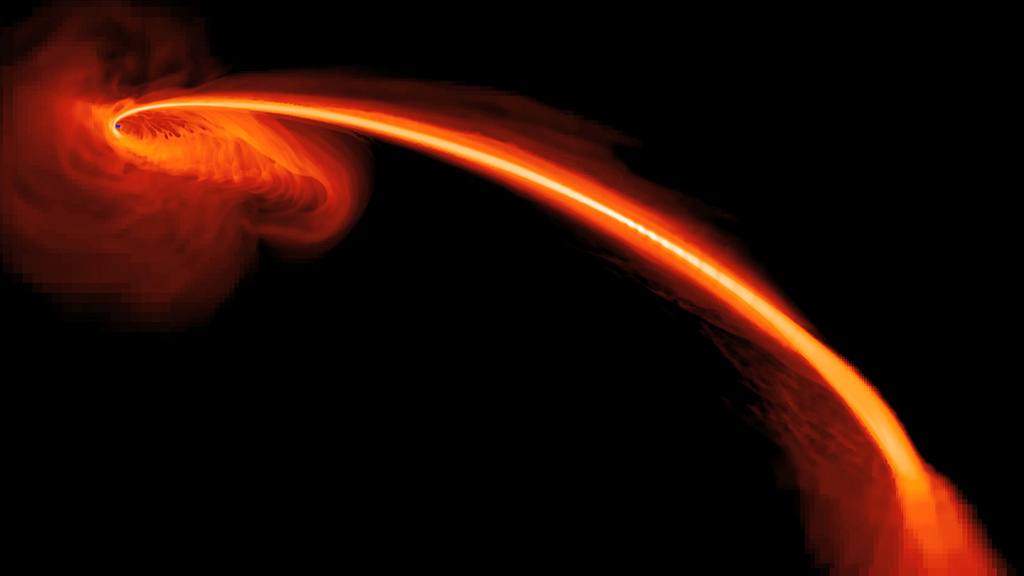 NASA; S. Gezari, The Johns Hopkins University; and J. Guillochon, University of California, Santa CruzThis computer simulation shows gas from a tidally shredded star falling into a black hole. Some of the gas also is being ejected at high speed into space.
NASA; S. Gezari, The Johns Hopkins University; and J. Guillochon, University of California, Santa CruzThis computer simulation shows gas from a tidally shredded star falling into a black hole. Some of the gas also is being ejected at high speed into space. -
‘Black Marble’
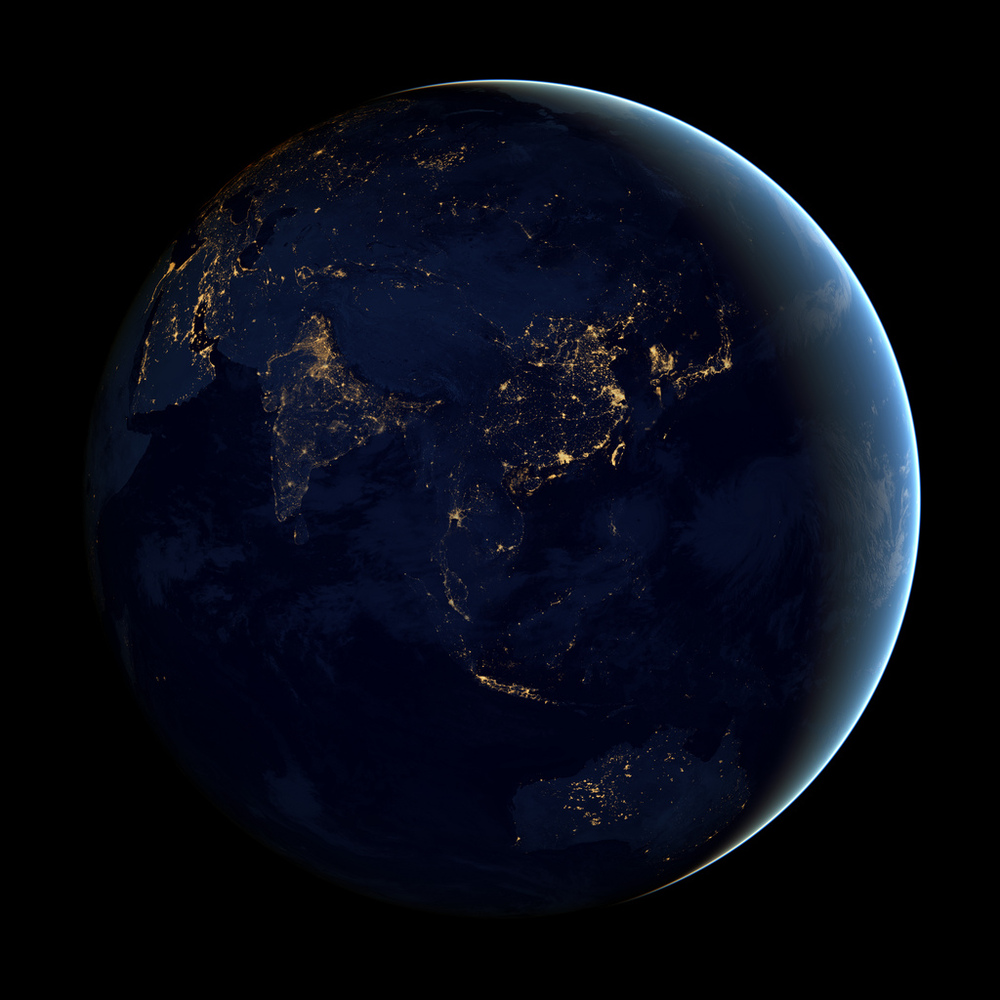 NASA Earth ObservatoryThis image of Asia and Australia at night is a composite assembled from data acquired by the Suomi NPP satellite in April and October 2012.
NASA Earth ObservatoryThis image of Asia and Australia at night is a composite assembled from data acquired by the Suomi NPP satellite in April and October 2012. -
Ring Nebula
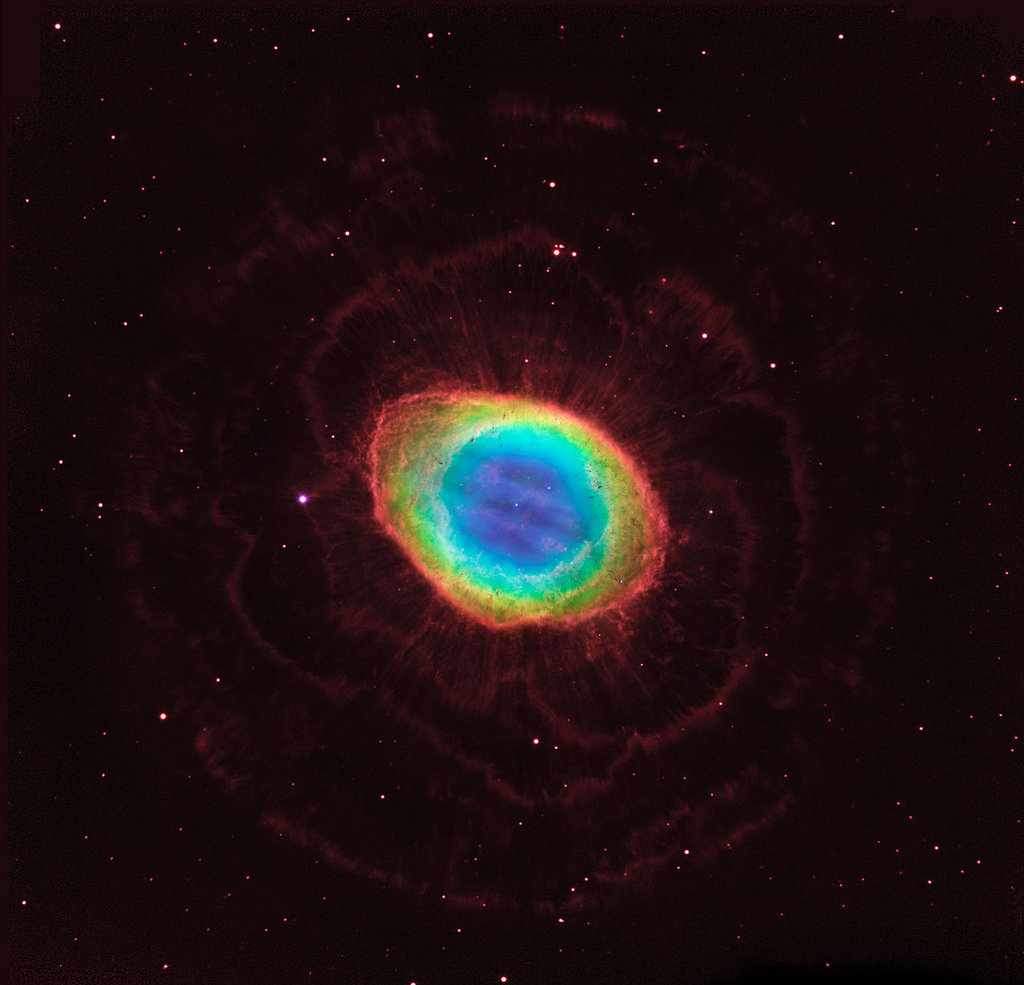 NASA, ESA, C.R. Robert O’Dell (Vanderbilt University), G.J. Ferland (University of Kentucky), W.J. Henney and M. Peimbert (National Autonomous University of Mexico) Credit for Large Binocular Telescope data: David Thompson (University of Arizona)In this composite image, visible-light observations by NASA’s Hubble Space Telescope are combined with infrared data from the ground-based Large Binocular Telescope in Arizona to assemble a dramatic view of the well-known Ring Nebula.
NASA, ESA, C.R. Robert O’Dell (Vanderbilt University), G.J. Ferland (University of Kentucky), W.J. Henney and M. Peimbert (National Autonomous University of Mexico) Credit for Large Binocular Telescope data: David Thompson (University of Arizona)In this composite image, visible-light observations by NASA’s Hubble Space Telescope are combined with infrared data from the ground-based Large Binocular Telescope in Arizona to assemble a dramatic view of the well-known Ring Nebula. -
Supernova Remnant
 Credit: NASA, ESA, and the Hubble Heritage Team (STScI/AURA) Acknowledgment: W. Blair (Johns Hopkins University)A delicate ribbon of gas floats eerily in our galaxy. A contrail from an alien spaceship? A jet from a black-hole? Actually this image, taken by NASA’s Hubble Space Telescope, is a thin section of a supernova remnant caused by a stellar explosion that occurred more than 1,000 years ago.
Credit: NASA, ESA, and the Hubble Heritage Team (STScI/AURA) Acknowledgment: W. Blair (Johns Hopkins University)A delicate ribbon of gas floats eerily in our galaxy. A contrail from an alien spaceship? A jet from a black-hole? Actually this image, taken by NASA’s Hubble Space Telescope, is a thin section of a supernova remnant caused by a stellar explosion that occurred more than 1,000 years ago. -
Jupiter and Ganymede
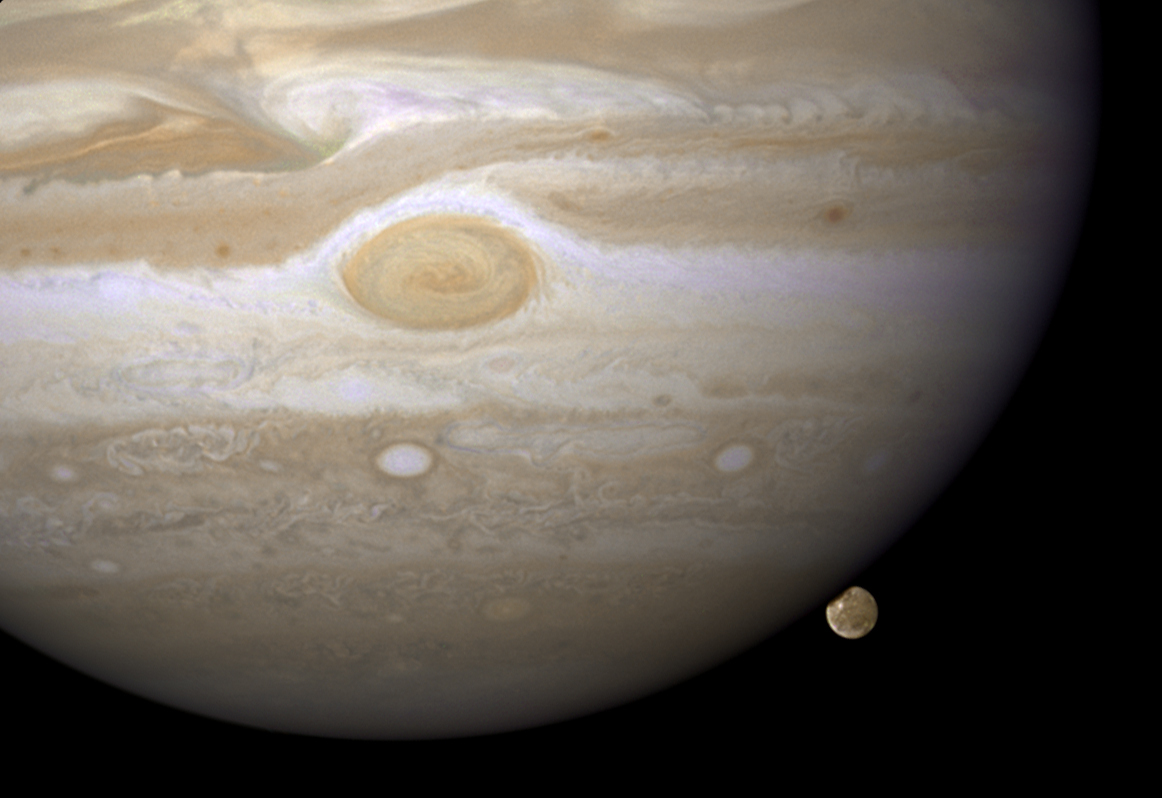 NASA, ESA, and E. Karkoschka (University of Arizona)NASA’s Hubble Space Telescope caught Jupiter’s moon Ganymede playing a game of “peek-a-boo.” In this crisp image, Ganymede is shown just before it ducks behind the giant planet.
NASA, ESA, and E. Karkoschka (University of Arizona)NASA’s Hubble Space Telescope caught Jupiter’s moon Ganymede playing a game of “peek-a-boo.” In this crisp image, Ganymede is shown just before it ducks behind the giant planet. -
Crab Nebula
 NASA, ESA, J. Hester and A. Loll (Arizona State University)The Crab Nebula is a supernova remnant, all that remains of a tremendous stellar explosion. Observers in China and Japan recorded the supernova nearly 1,000 years ago, in 1054.
NASA, ESA, J. Hester and A. Loll (Arizona State University)The Crab Nebula is a supernova remnant, all that remains of a tremendous stellar explosion. Observers in China and Japan recorded the supernova nearly 1,000 years ago, in 1054. -
Lagoon Nebula
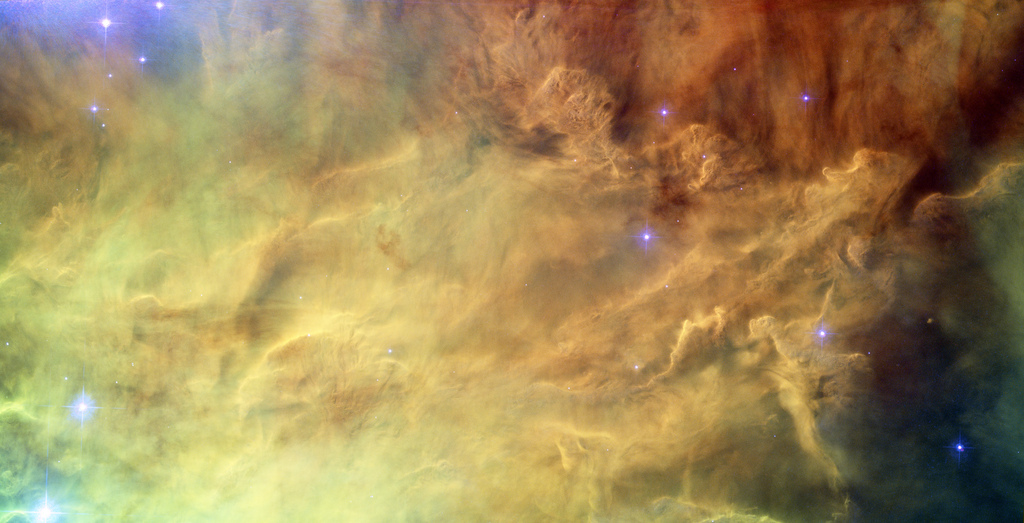 NASA, ESAA spectacular NASA/ESA Hubble Space Telescope image reveals the heart of the Lagoon Nebula. Seen as a massive cloud of glowing dust and gas, bombarded by the energetic radiation of new stars, this placid name hides a dramatic reality.
NASA, ESAA spectacular NASA/ESA Hubble Space Telescope image reveals the heart of the Lagoon Nebula. Seen as a massive cloud of glowing dust and gas, bombarded by the energetic radiation of new stars, this placid name hides a dramatic reality. -
Mercury
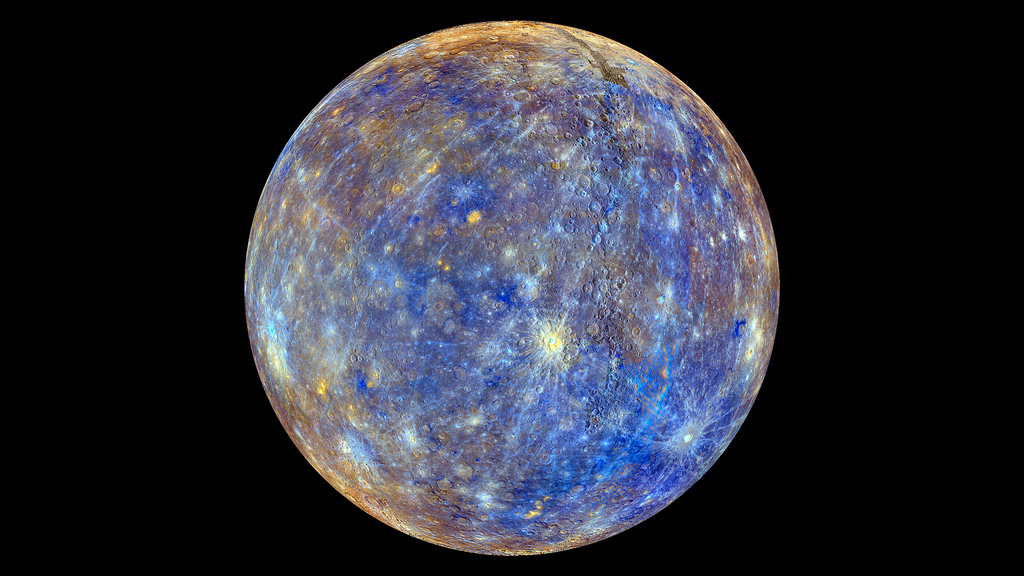 NASA/Johns Hopkins University Applied Physics Laboratory/Carnegie Institution of WashingtonThis colorful view of Mercury was produced by using images from the color base map imaging campaign during the spacecraft MESSENGER’s primary mission. The colors are not what Mercury would look like to the human eye, but rather the colors enhance the chemical, mineralogical, and physical differences between the rocks that make up Mercury’s surface.
NASA/Johns Hopkins University Applied Physics Laboratory/Carnegie Institution of WashingtonThis colorful view of Mercury was produced by using images from the color base map imaging campaign during the spacecraft MESSENGER’s primary mission. The colors are not what Mercury would look like to the human eye, but rather the colors enhance the chemical, mineralogical, and physical differences between the rocks that make up Mercury’s surface. -
Cat’s Eye Nebula
 NASA, ESA, HEIC, and The Hubble Heritage Team (STScI/AURA) Acknowledgment: R. Corradi (Isaac Newton Group of Telescopes, Spain) and Z. Tsvetanov (NASA)The Cat’s Eye Nebula, one of the first planetary nebulae discovered, also has one of the most complex forms known to this kind of nebula. Eleven rings, or shells, of gas make up the Cat’s Eye. Each ‘ring’ is actually the edge of a spherical bubble seen projected onto the sky — that’s why it appears bright along its outer edge.
NASA, ESA, HEIC, and The Hubble Heritage Team (STScI/AURA) Acknowledgment: R. Corradi (Isaac Newton Group of Telescopes, Spain) and Z. Tsvetanov (NASA)The Cat’s Eye Nebula, one of the first planetary nebulae discovered, also has one of the most complex forms known to this kind of nebula. Eleven rings, or shells, of gas make up the Cat’s Eye. Each ‘ring’ is actually the edge of a spherical bubble seen projected onto the sky — that’s why it appears bright along its outer edge. -
Spiral Galaxy
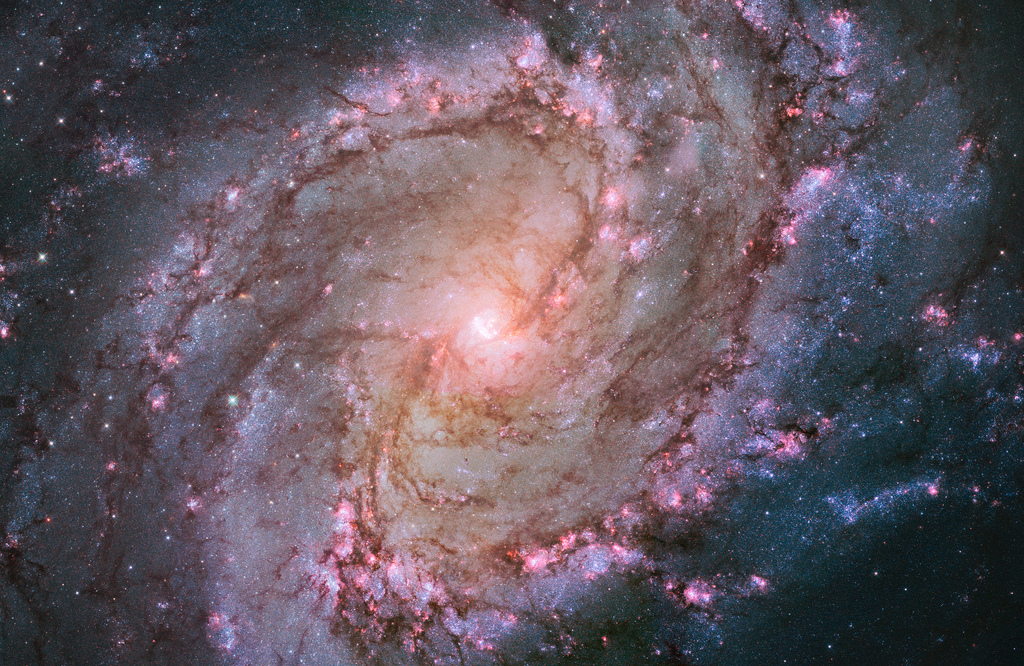 NASA, ESA, and the Hubble Heritage Team (STScI/AURA) Acknowledgement: W. Blair (STScI/Johns Hopkins University) and R. O’Connell (University of Virginia)The vibrant magentas and blues in this Hubble image of the barred spiral galaxy M83 reveal that the galaxy is ablaze with star formation. Also known as the Southern Pinwheel, the galaxy lies 15 million light-years away in the constellation Hydra.
NASA, ESA, and the Hubble Heritage Team (STScI/AURA) Acknowledgement: W. Blair (STScI/Johns Hopkins University) and R. O’Connell (University of Virginia)The vibrant magentas and blues in this Hubble image of the barred spiral galaxy M83 reveal that the galaxy is ablaze with star formation. Also known as the Southern Pinwheel, the galaxy lies 15 million light-years away in the constellation Hydra. -
Aurora
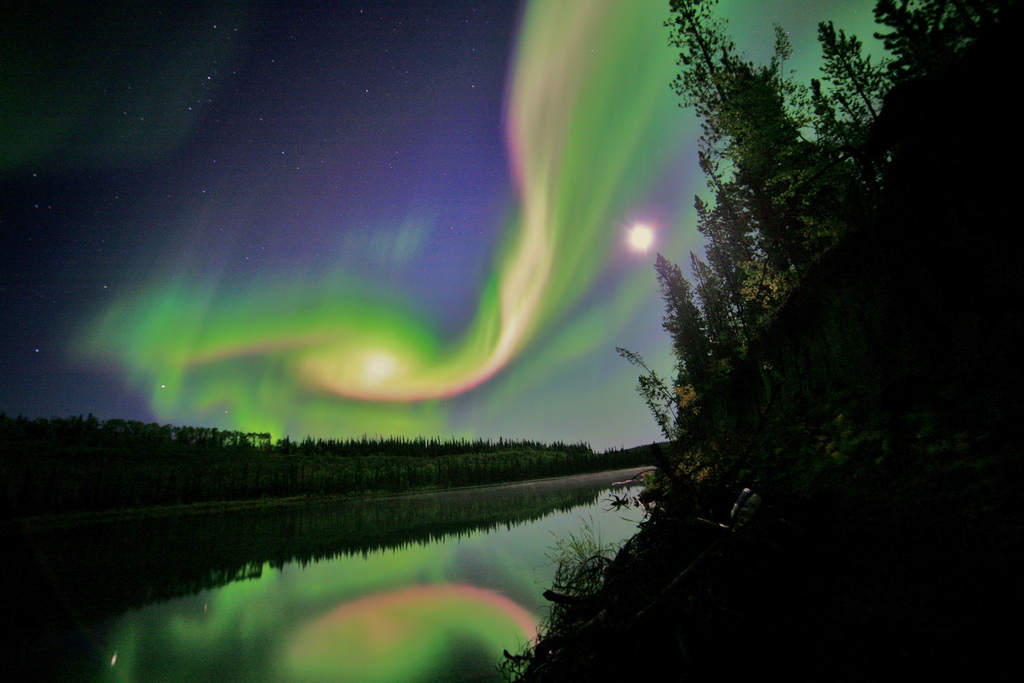 Courtesy of David Cartier, Sr.Swirls of green and red appear in an aurora over Whitehorse, Yukon on the night of September 3, 2012. The aurora was due to a coronal mass ejection from the sun, which erupted on August 31.
Courtesy of David Cartier, Sr.Swirls of green and red appear in an aurora over Whitehorse, Yukon on the night of September 3, 2012. The aurora was due to a coronal mass ejection from the sun, which erupted on August 31. -
Eta Carinae
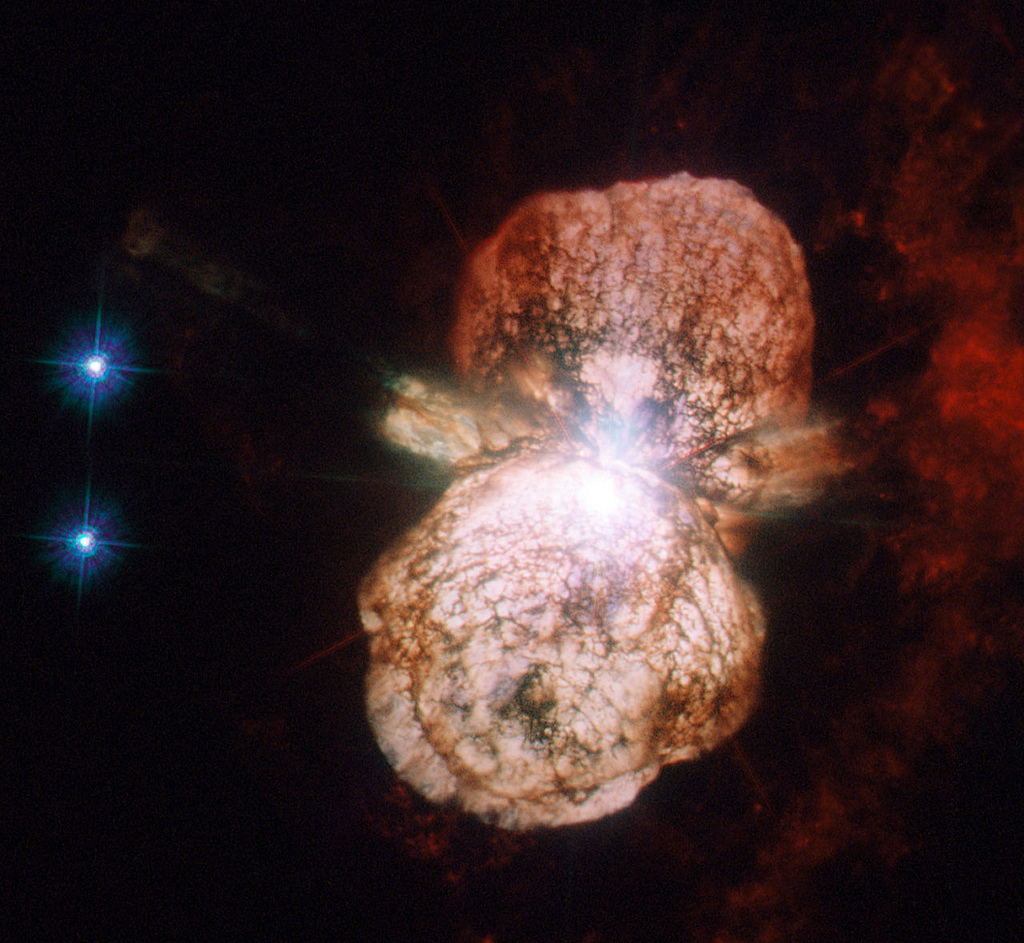 ESA/NASANASA’s Hubble Telescope captured an image of the binary star system Eta Carinae. This image consists of ultraviolet and visible light images from the High Resolution Channel of Hubble’s Advanced Camera for Surveys.
ESA/NASANASA’s Hubble Telescope captured an image of the binary star system Eta Carinae. This image consists of ultraviolet and visible light images from the High Resolution Channel of Hubble’s Advanced Camera for Surveys. -
Saturn’s Moons
 NASA/JPL/Space Science InstituteSaturn’s orange moon Titan peeks from behind two of Saturn’s rings. Small, battered Epimetheus, another of Saturn’s 62 moons, appears just above the rings.
NASA/JPL/Space Science InstituteSaturn’s orange moon Titan peeks from behind two of Saturn’s rings. Small, battered Epimetheus, another of Saturn’s 62 moons, appears just above the rings. -
Europa
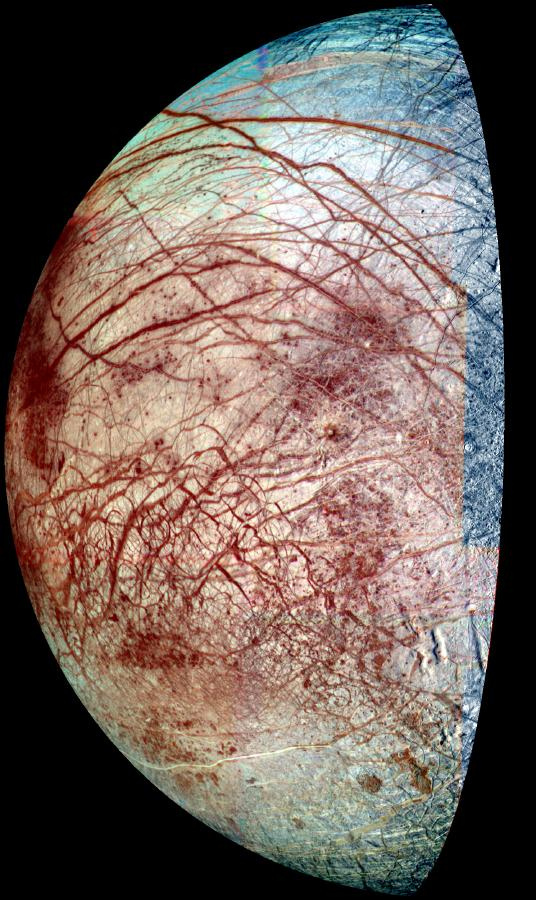 NASA/JPL/University of ArizonaThe icy surface of Europa is shown strewn with cracks, ridges and “chaotic terrain,” where the surface has been disrupted and ice blocks have moved around. New laboratory experiments show that water ice and frozen sulfur dioxide react even at the frigid temperatures of Europa. Because the reaction occurs without the aid of radiation, it could take place throughout the moon’s thick ice layer—an outcome that would revamp current thinking about the chemistry and geology of this moon and perhaps others.
NASA/JPL/University of ArizonaThe icy surface of Europa is shown strewn with cracks, ridges and “chaotic terrain,” where the surface has been disrupted and ice blocks have moved around. New laboratory experiments show that water ice and frozen sulfur dioxide react even at the frigid temperatures of Europa. Because the reaction occurs without the aid of radiation, it could take place throughout the moon’s thick ice layer—an outcome that would revamp current thinking about the chemistry and geology of this moon and perhaps others. -
Saturn’s Auroras
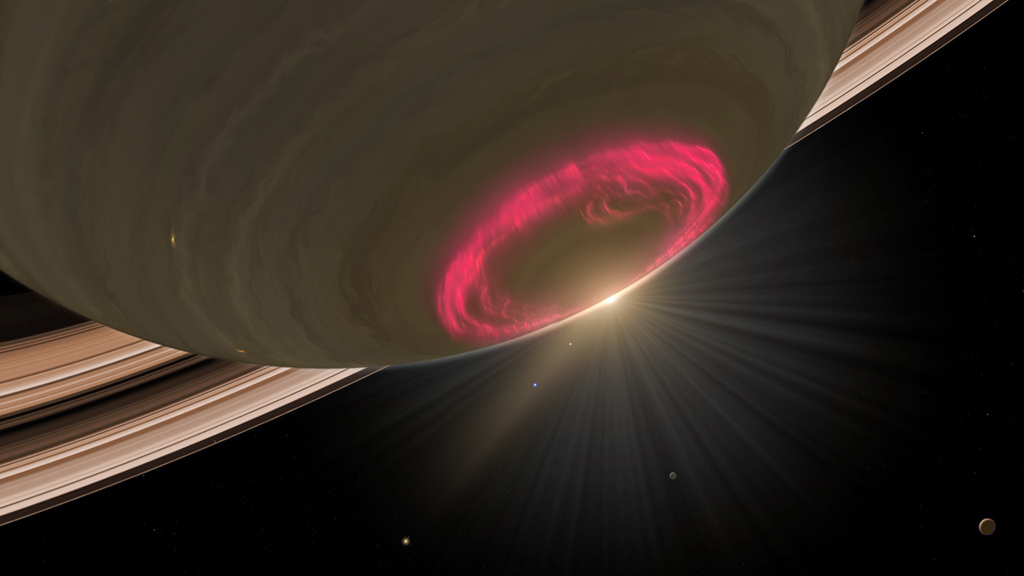 NASAScientists first observed Saturn’s auroras in 1979. Decades later, these shimmering ribbons of light still fascinate. For one thing they’re magnificently tall, rising hundreds of miles above the planet’s poles. And unlike on Earth, where bright displays fizzle after only a few hours, auroras on Saturn can shine for days. Auroras are produced when speeding particles accelerated by the sun’s energy collide with gases in a planet’s atmosphere. The gases fluoresce, emitting flashes of light at different wavelengths.
NASAScientists first observed Saturn’s auroras in 1979. Decades later, these shimmering ribbons of light still fascinate. For one thing they’re magnificently tall, rising hundreds of miles above the planet’s poles. And unlike on Earth, where bright displays fizzle after only a few hours, auroras on Saturn can shine for days. Auroras are produced when speeding particles accelerated by the sun’s energy collide with gases in a planet’s atmosphere. The gases fluoresce, emitting flashes of light at different wavelengths. -
‘Star Formation Laboratory’
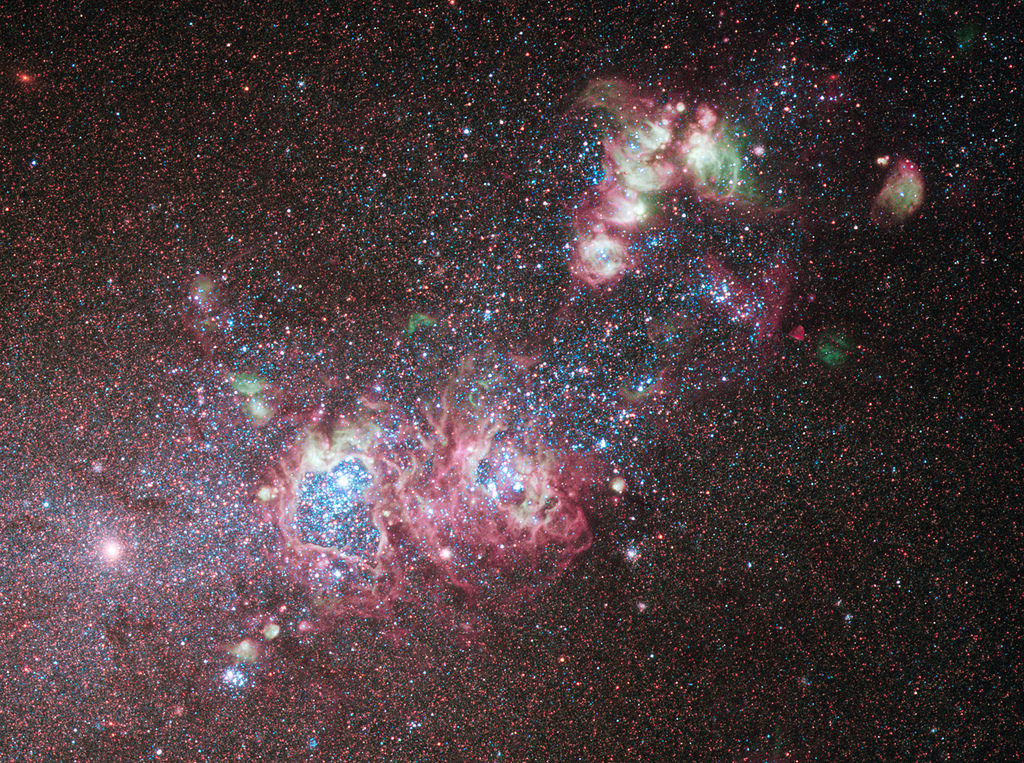 NASA, ESA, and the Hubble Heritage (STScI/AURA)-ESA/Hubble CollaborationThe dwarf galaxy NGC 4214 is ablaze with young stars and gas clouds. Located around 10 million light-years away in the constellation of Canes Venatici (The Hunting Dogs), the galaxy’s close proximity, combined with the wide variety of evolutionary stages among the stars, make it an ideal laboratory to research the triggers of star formation and evolution.
NASA, ESA, and the Hubble Heritage (STScI/AURA)-ESA/Hubble CollaborationThe dwarf galaxy NGC 4214 is ablaze with young stars and gas clouds. Located around 10 million light-years away in the constellation of Canes Venatici (The Hunting Dogs), the galaxy’s close proximity, combined with the wide variety of evolutionary stages among the stars, make it an ideal laboratory to research the triggers of star formation and evolution. -
Coronal Mass Ejection
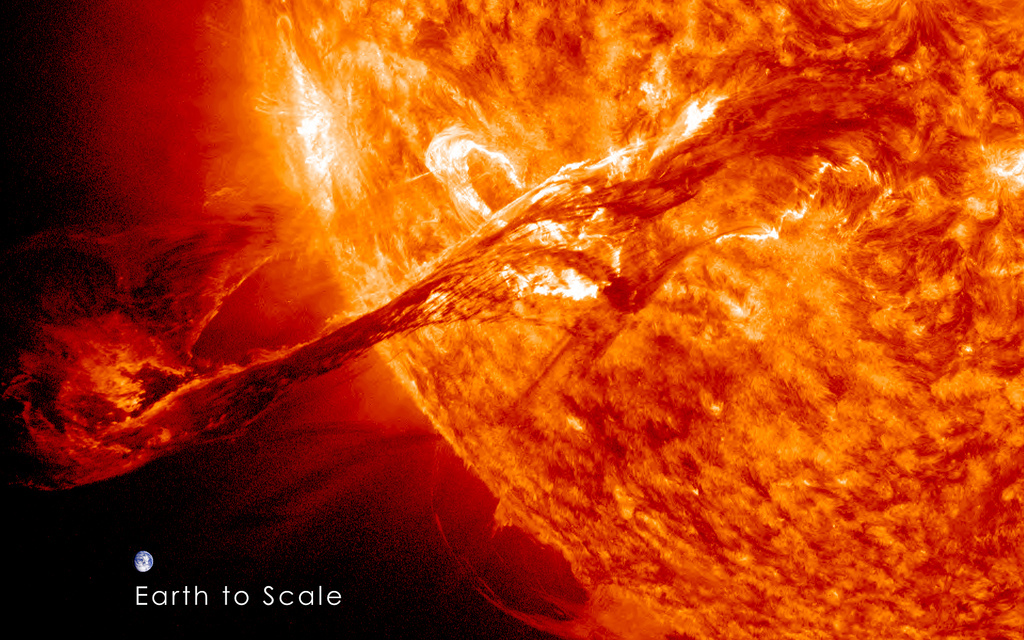 NASA/GSFC/SDOOn August 31, 2012 a long filament of solar material that had been hovering in the sun’s atmosphere, the corona, erupted out into space. The coronal mass ejection, or CME, traveled at over 900 miles per second. The CME did not travel directly toward Earth, but did connect with Earth’s magnetic environment, or magnetosphere, causing auroras to appear on the night of Monday, September 3.
NASA/GSFC/SDOOn August 31, 2012 a long filament of solar material that had been hovering in the sun’s atmosphere, the corona, erupted out into space. The coronal mass ejection, or CME, traveled at over 900 miles per second. The CME did not travel directly toward Earth, but did connect with Earth’s magnetic environment, or magnetosphere, causing auroras to appear on the night of Monday, September 3. -
Centaurus A
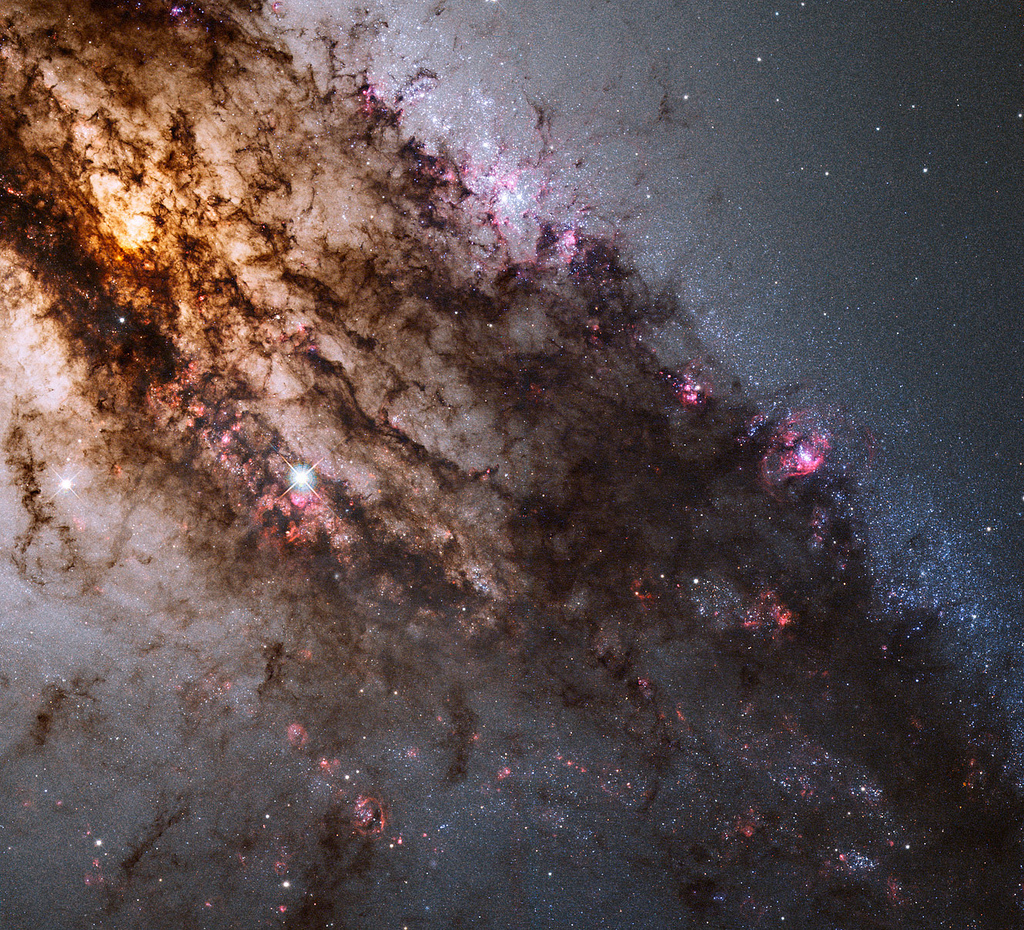 NASA/Cheryl Gundy, STSCIResembling looming rain clouds on a stormy day, dark lanes of dust crisscross the giant elliptical galaxy Centaurus A. Hubble’s panchromatic vision, stretching from ultraviolet through near-infrared wavelengths, reveals the vibrant glow of young, blue star clusters and a glimpse into regions normally obscured by the dust.
NASA/Cheryl Gundy, STSCIResembling looming rain clouds on a stormy day, dark lanes of dust crisscross the giant elliptical galaxy Centaurus A. Hubble’s panchromatic vision, stretching from ultraviolet through near-infrared wavelengths, reveals the vibrant glow of young, blue star clusters and a glimpse into regions normally obscured by the dust. -
Andromeda Galaxy
 NASA/Swift/Stefan Immler (GSFC) and Erin Grand (UMCP)This mosaic of M31 merges 330 individual images taken by the Ultraviolet/Optical Telescope aboard NASA’s Swift spacecraft. It is the highest-resolution image of the galaxy ever recorded in the ultraviolet.
NASA/Swift/Stefan Immler (GSFC) and Erin Grand (UMCP)This mosaic of M31 merges 330 individual images taken by the Ultraviolet/Optical Telescope aboard NASA’s Swift spacecraft. It is the highest-resolution image of the galaxy ever recorded in the ultraviolet. -
Mickey Mouse On Mercury?
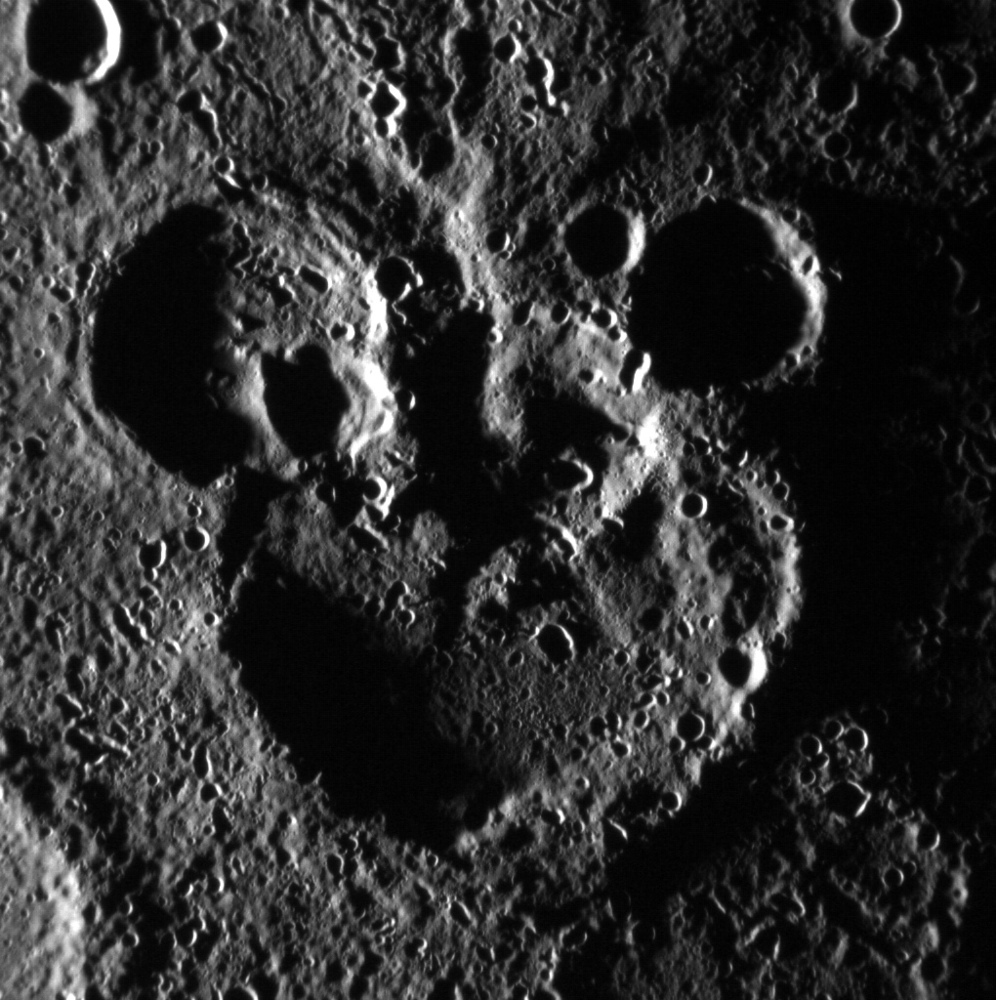 NASA/Johns Hopkins University Applied Physics Laboratory/Carnegie Institution of WashingtonThis scene is to the northwest of the crater Magritte, in Mercury’s south. The image is not map projected; the larger crater actually sits to the north of the two smaller ones. The shadowing helps define the striking “Mickey Mouse” resemblance, created by the accumulation of craters over Mercury’s long geologic history.
NASA/Johns Hopkins University Applied Physics Laboratory/Carnegie Institution of WashingtonThis scene is to the northwest of the crater Magritte, in Mercury’s south. The image is not map projected; the larger crater actually sits to the north of the two smaller ones. The shadowing helps define the striking “Mickey Mouse” resemblance, created by the accumulation of craters over Mercury’s long geologic history. -
Aurora From Space
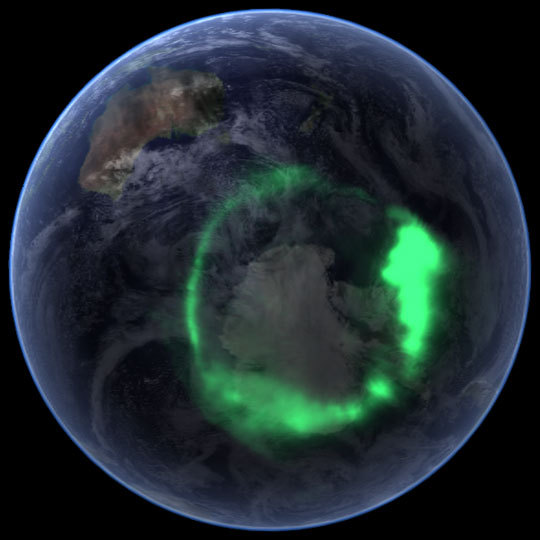 NASA/Goddard Space Flight Center Scientific Visualization StudioFrom space, the aurora is a crown of light that circles each of Earth’s poles. The IMAGE satellite captured this view of the aurora australis (southern lights) on September 11, 2005, four days after a record-setting solar flare sent plasma—an ionized gas of protons and electrons—flying towards the Earth. The ring of light that the solar storm generated over Antarctica glows green in the ultraviolet part of the spectrum, shown in this image. From the Earth’s surface, the ring would appear as a curtain of light shimmering across the night sky.
NASA/Goddard Space Flight Center Scientific Visualization StudioFrom space, the aurora is a crown of light that circles each of Earth’s poles. The IMAGE satellite captured this view of the aurora australis (southern lights) on September 11, 2005, four days after a record-setting solar flare sent plasma—an ionized gas of protons and electrons—flying towards the Earth. The ring of light that the solar storm generated over Antarctica glows green in the ultraviolet part of the spectrum, shown in this image. From the Earth’s surface, the ring would appear as a curtain of light shimmering across the night sky. -
Daybreak On Mars
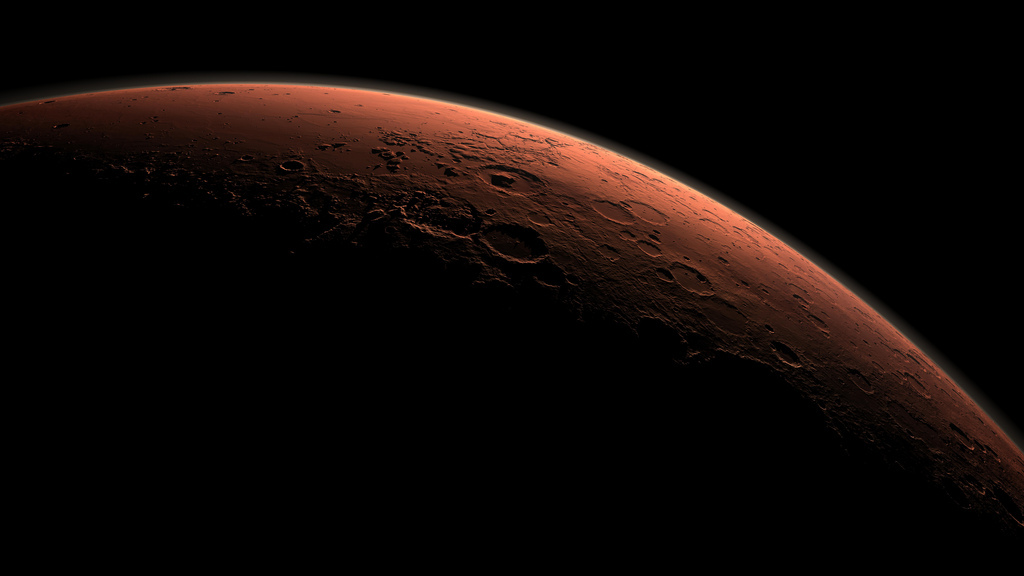 NASA/JPL-CaltechThis computer-generated view depicts part of Mars at the boundary between darkness and daylight. Gale Crater looms in the distance, distinguished from adjacent craters by its central mountain of strata. Gale Crater straddles the dichotomy boundary of Mars, which separates the broad, flat, and young northern plains from the much older and rougher southern highlands.
NASA/JPL-CaltechThis computer-generated view depicts part of Mars at the boundary between darkness and daylight. Gale Crater looms in the distance, distinguished from adjacent craters by its central mountain of strata. Gale Crater straddles the dichotomy boundary of Mars, which separates the broad, flat, and young northern plains from the much older and rougher southern highlands. -
Saturn
 NASA/JPL/Space Science InstituteAs Saturn’s rings orbit the planet, a section is typically in the planet’s shadow, experiencing a brief night lasting from 6 to 14 hours. However, about once every 15 years, night falls over the entire visible ring system for about four days. This happens during Saturn’s equinox, when the sun is directly over the planet’s equator. At this time, the rings, which also orbit directly over the planet’s equator, appear edge-on to the sun. During equinox, light from the sun hits the ring particles at very low angles, accenting their topography and giving us a three-dimensional view of the rings.
NASA/JPL/Space Science InstituteAs Saturn’s rings orbit the planet, a section is typically in the planet’s shadow, experiencing a brief night lasting from 6 to 14 hours. However, about once every 15 years, night falls over the entire visible ring system for about four days. This happens during Saturn’s equinox, when the sun is directly over the planet’s equator. At this time, the rings, which also orbit directly over the planet’s equator, appear edge-on to the sun. During equinox, light from the sun hits the ring particles at very low angles, accenting their topography and giving us a three-dimensional view of the rings. -
Jupiter
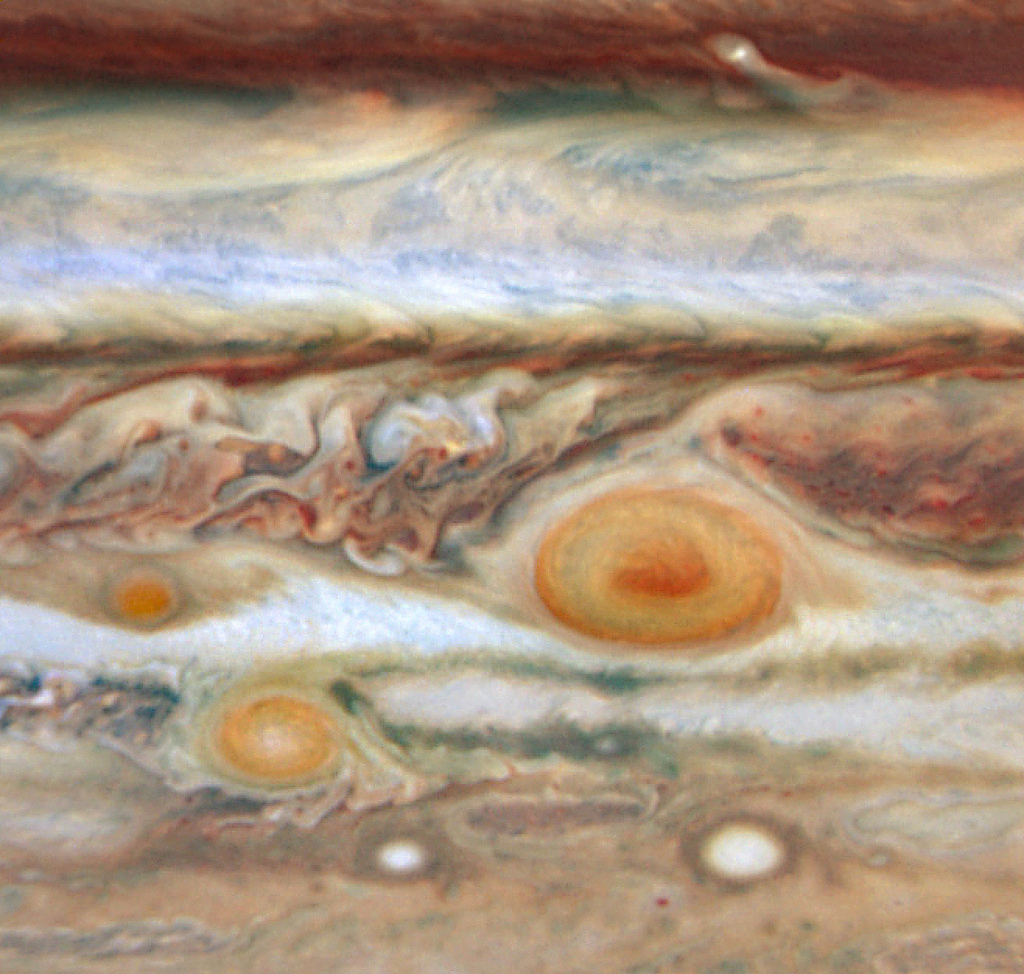 M. Wong and I. de Pater (University of California, Berkeley)New red spot appears on Jupiter.
M. Wong and I. de Pater (University of California, Berkeley)New red spot appears on Jupiter. -
Cygnus X
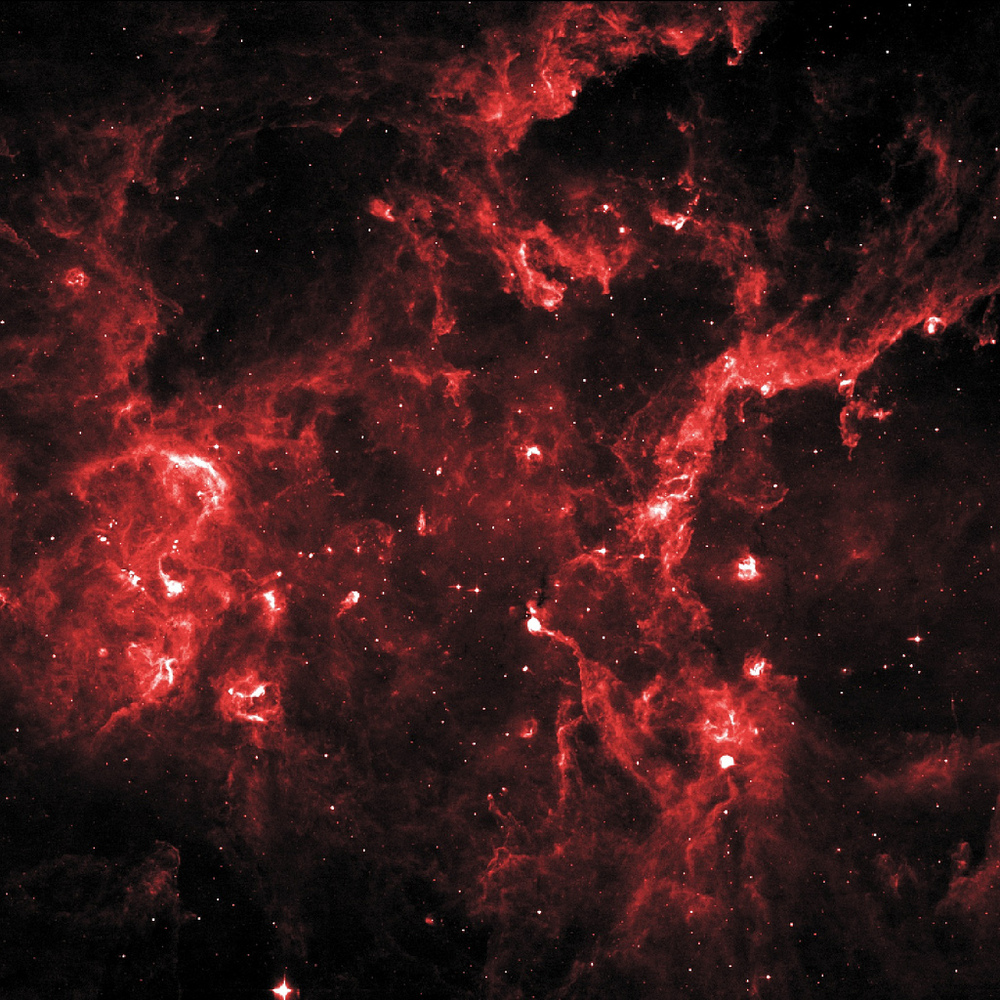 NASA/IPAC/MSXCygnus X hosts many young stellar groupings. The combined outflows and ultraviolet radiation from the region’s numerous massive stars have heated and pushed gas away from the clusters, producing cavities of hot, lower-density gas. In this infrared image, ridges of denser gas mark the boundaries of the cavities. Bright spots within these ridges show where stars are forming.
NASA/IPAC/MSXCygnus X hosts many young stellar groupings. The combined outflows and ultraviolet radiation from the region’s numerous massive stars have heated and pushed gas away from the clusters, producing cavities of hot, lower-density gas. In this infrared image, ridges of denser gas mark the boundaries of the cavities. Bright spots within these ridges show where stars are forming. -
Spiral Galaxy
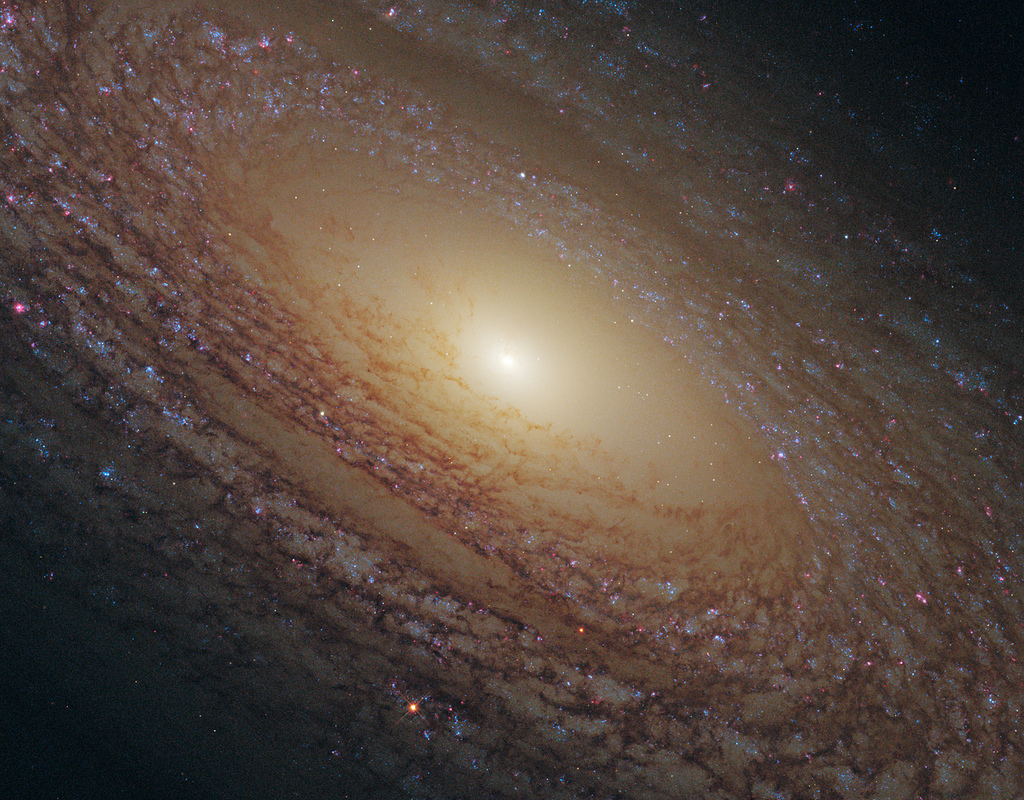 NASAThe Hubble Space Telescope revealed this majestic disk of stars and dust lanes in this view of the spiral galaxy NGC 2841. A bright cusp of starlight marks the galaxy’s center. Spiraling outward are dust lanes that are silhouetted against the population of whitish middle-aged stars. Much younger blue stars trace the spiral arms.
NASAThe Hubble Space Telescope revealed this majestic disk of stars and dust lanes in this view of the spiral galaxy NGC 2841. A bright cusp of starlight marks the galaxy’s center. Spiraling outward are dust lanes that are silhouetted against the population of whitish middle-aged stars. Much younger blue stars trace the spiral arms.
